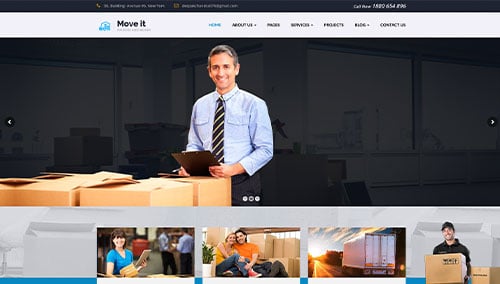Hello, moving enthusiasts! Want to enhance your online presence and attract more customers to your moving company? Our guide to the top 45 moving company websites is here to help.
Our online marketing agency has carefully evaluated the best moving sites, taking into account factors such as design, functionality, uniqueness, and user experience. From visually stunning designs to intuitive navigation, these sites embody excellence in the moving industry.
Not only will you find inspiration for your own website, but also gain valuable tips on how to make your online presence stand out from the competition.
Improve your moving business with the help of this guide, and create an online presence that showcases the professionalism and attention to detail of your moving services! You’ll find website examples of residential & commercial moving services, international moving companies, packing & unpacking services, and storage companies in this list! For examples within other industries, check out our 2025 leading web designs writeup!
Top Moving Company Website Designs
- 1. Moving APT
- 2. NorthStar Moving Company
- 3. 24/7 Logistic Services
- 4. U-Haul
- 5. Mayflower
- 6. Bold Moving & Storage
- 7. Falcon Moving
- 8. Packer Freight
- 9. Square Cow Movers
- 10. Sunrise Moving and Packing
- 11. Meathead Movers
- 12. Colonial Van Lines
- 13. Great Chicago Movers LLC
- 14. TWO MEN AND A TRUCK
- 15. Cross Country Moving Group
- 16. National Van Lines
- 17. Minne Movers
- 18. Gentle Giant Moving Company
- 19. A1 Movers
- 20. Pure Moving
- 21. Pack-Men Movers
- 22. Relief Moving Company
- 23. Accurate Express Movers
- 24. Interstate Moving & Relocation Group
- 25. American Van Lines
- 26. 1-800-PACK-RAT
- 27. Great Home Movers
- 28. Cheap Movers Los Angeles
- 29. New City Moving
- 30. Bellhop
- 31. Solomon & Sons Relocation Services
- 32. Bekins
- 33. JK Moving Services
- 34. North American Van Lines
- 35. Allied
- 36. College H.U.N.K.S. Hauling Junk & Moving
- 37. College Muscle Movers
- 38. Arizona Discount Movers
- 39. 2 Fellas Moving Company
- 40. Unpakt
- 41. Dreiske Moving & Storage
- 42. Atlas Van Lines
- 43. Einstein Moving Company
- 44. U-Pack
- 45. Pods
1. Moving APT
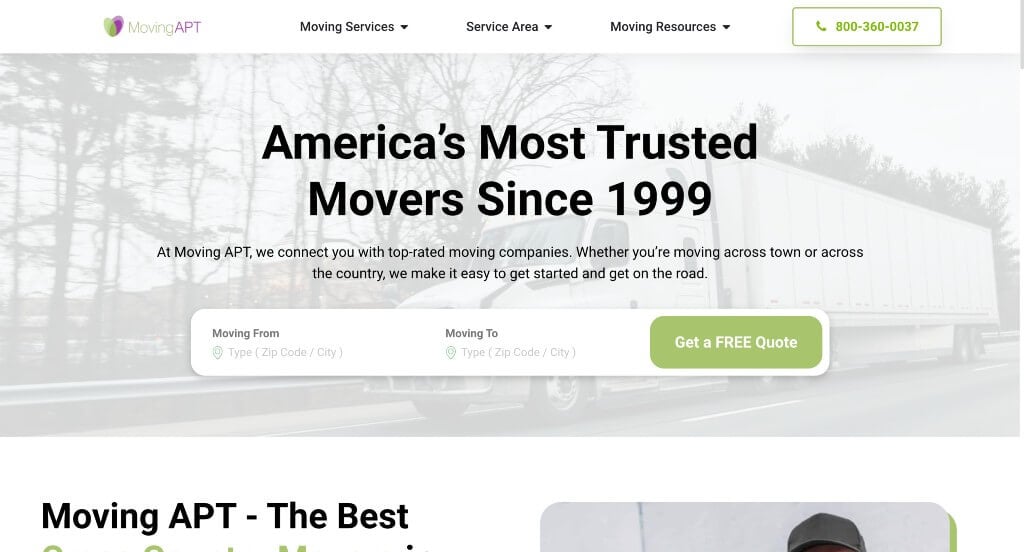
This is a great moving company’s web design example for anyone who is looking for a professional look and feel for their next site. As you scroll through the homepage of this website, one of the qualities you’ll notice right away is creative framing for their imagery. The inclusion of videos was a unique choice for a custom site. They had website marketing in mind when building the feeling of unity throughout their website. What a great website to review when building out your next website!
2. NorthStar Moving Company
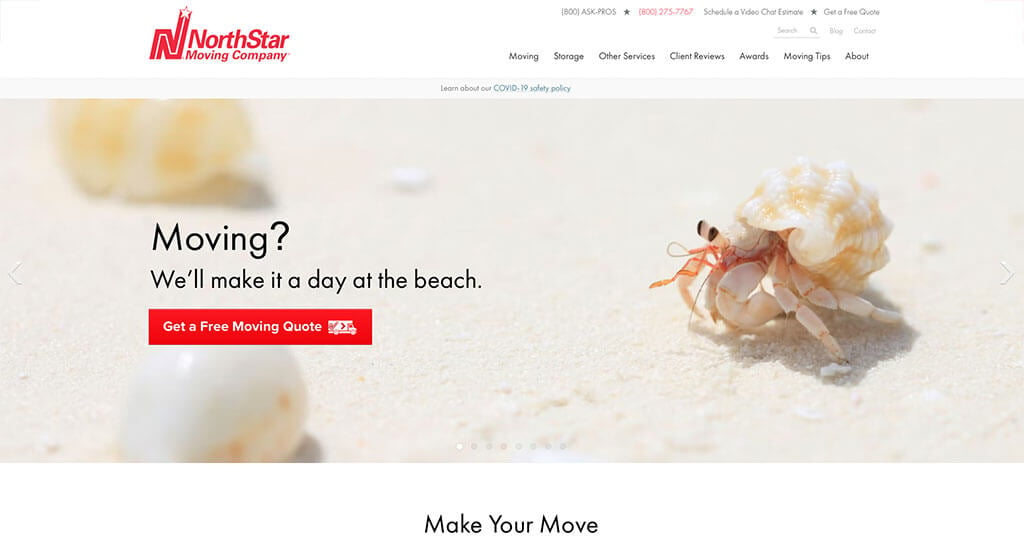
This is a good example of a web design for moving companies who are looking for a custom website. Our web designers thought this website was a good example for moving companies because their use of graphics and textures for a backdrop. The well labeled navigation bar was another reason why we included this website in our rankings for the top web design ideas for moving companies. NorthStar Moving Company had conversions in mind when designing the basic and professional text for their website. Give some thought to the creative design of this moving company’s website when developing your next custom website.
3. 24/7 Logistic Services
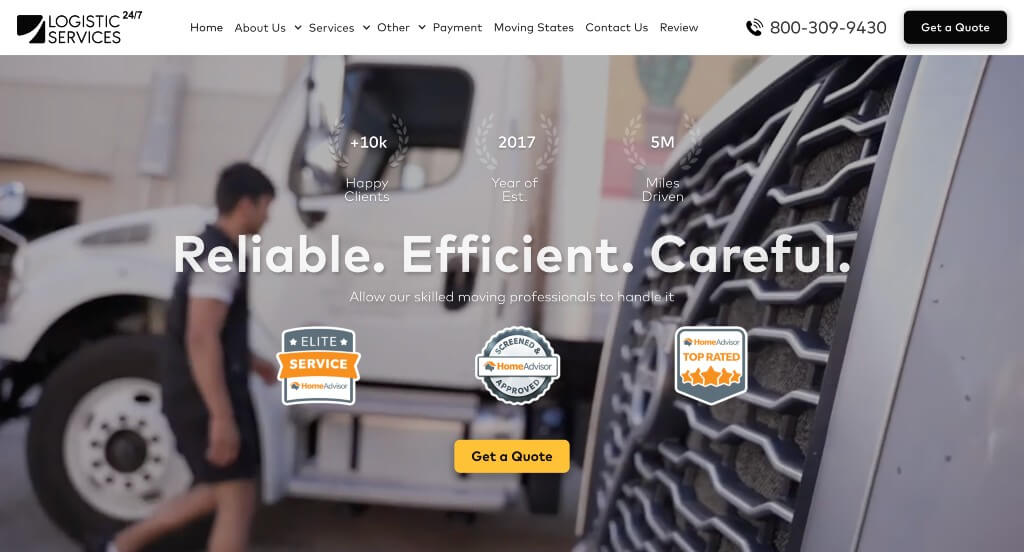
This is a great example for moving companies who are looking for a professional website layout. The use of a calming color scheme was probably the most impactful feature in the homepage of 24/7 Logistic Services. The incorporation of customer reviews was a nice touch for a unique website. Their high quality visuals helped make this one of the best moving company websites we reviewed. For moving companies looking for ideas for their next website, this example will definitely be one to consider.
4. U-Haul
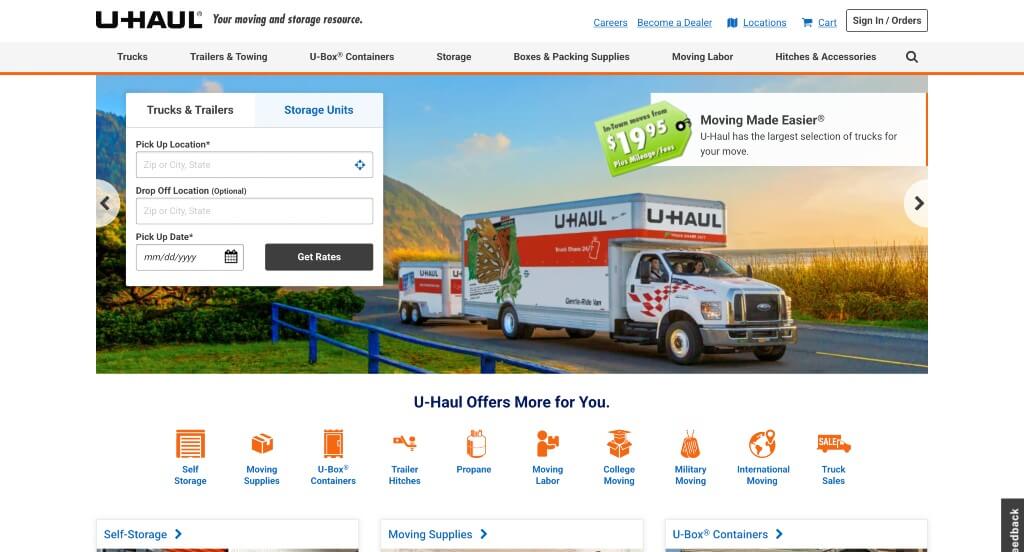
This is a good example of a moving company website design for someone who is looking for a professional layout. Of all the professional moving company websites we reviewed, one of the features in this custom website we liked was their interesting color scheme. The professional font choice was another design quality in this custom moving company website we enjoyed. Their clearly labeled menu helped make this one of the top moving company websites we reviewed. Don’t skip past this website when hunting for design ideas for your next moving company website!
5. Mayflower
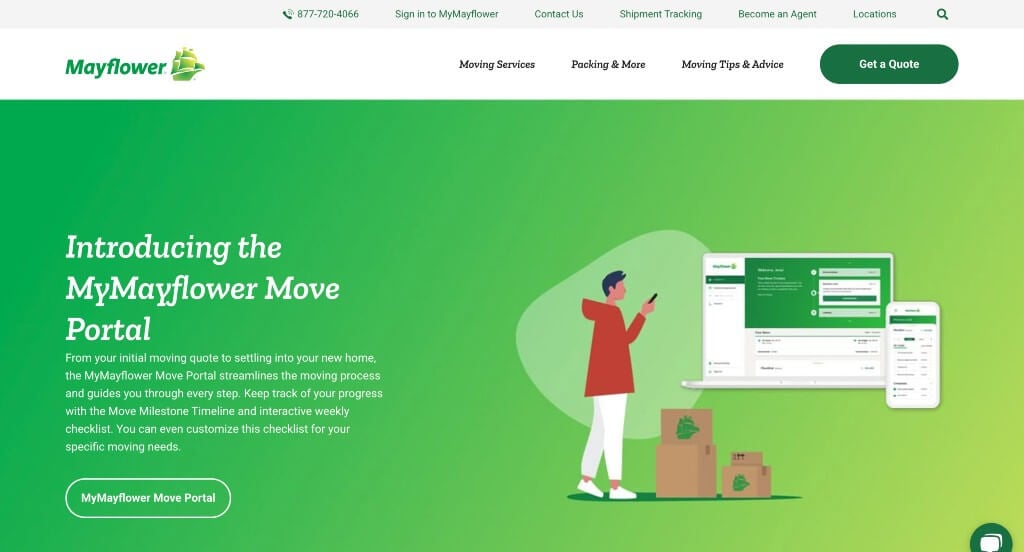
For a moving company website, they did a great job utilizing the white, black and green colors throughout their site. Our web designers thought this website was a good example for moving companies because of their interesting graphics. Another thoughtful quality in this creative moving company website was the inclusion of a blog. They clearly had ease of use in mind when building the navigation bar with organized categories for their website. Be sure to consider the one-of-a-kind design of this moving company website when developing your next website.
6. Bold Moving & Storage
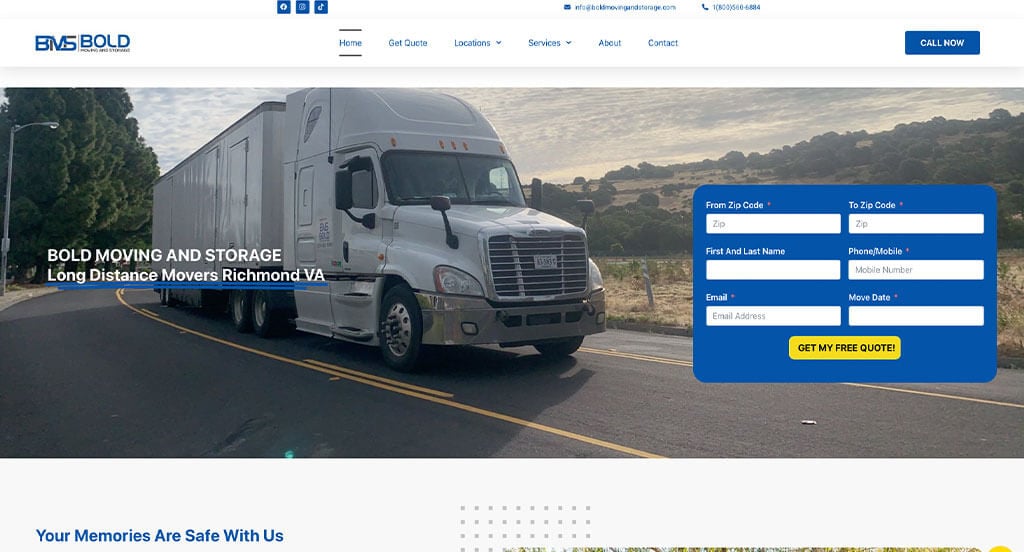
This is a great web design example for moving companies who are looking for a professional look and feel for their next site. The use of buttons to enhance usability was definitely the most impactful quality in the homepage of this website. The high-quality visuals were a good choice for a unique website. They clearly had conversions in mind when creating the blue accents for their website. If you are looking for template ideas for your next moving company site, be sure to check this one out.
Related: Moving companies can benefit from digital marketing for contractors by utilizing conversion funnels to build out email lists for future marketing efforts, in addition to social media marketing and online reputation management.
7. Falcon Moving
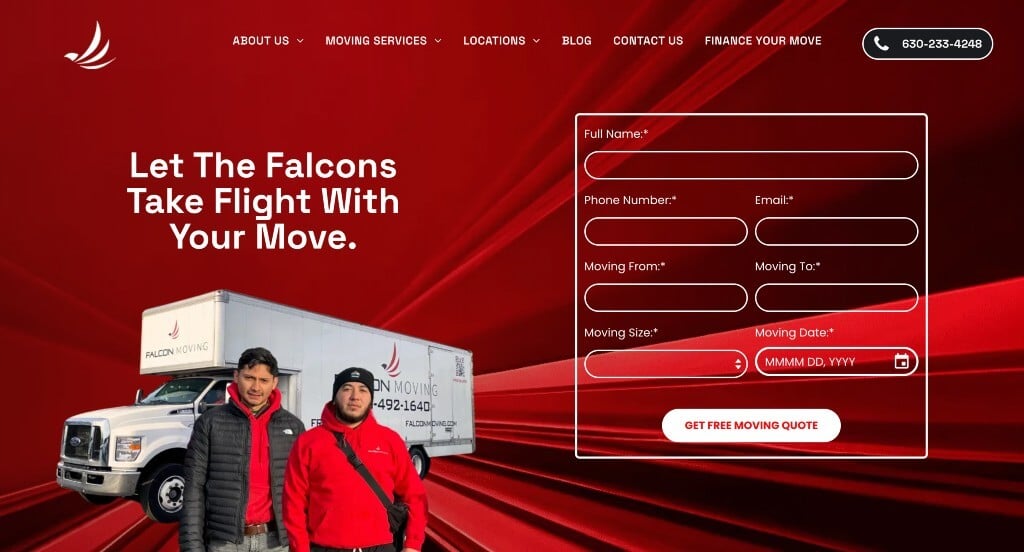
Upon entering this site, bright red is used in many areas in order to create something outstanding. Not only did red show up to highlight their buttons and icons, but it also showed up in their images to create unity throughout their pages. Including a map that helps people to understand where they provide services for was a great idea. They used a domain that was logical which was very helpful for brand recognition.
8. Packer Freight
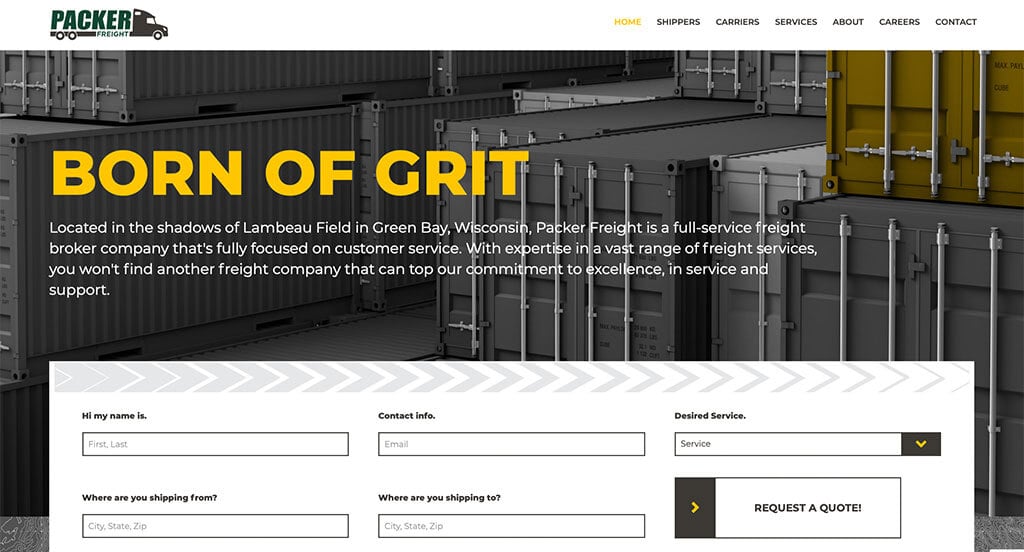
This is a great web design example for moving companies who are looking for a professional look and feel for their next site. Our web designers thought this website was a good design idea for moving companies because of their variety of textures seen throughout the site. The interesting fonts was another thoughtful feature in this custom moving company site we enjoyed. They clearly had internet marketing in mind when designing the well-labeled navigation bar for their website. What a great website to review when designing your next website!
9. Square Cow Movers
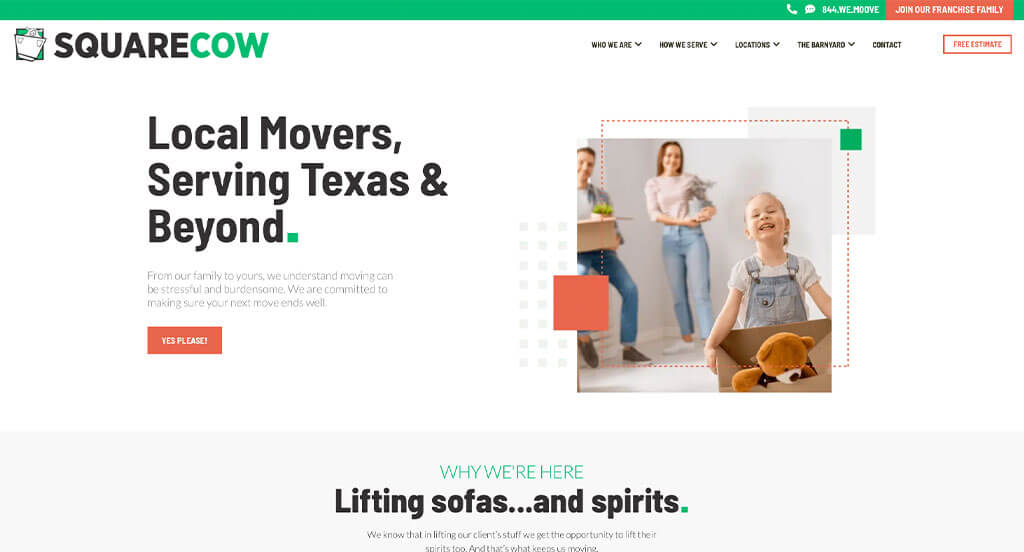
This is a creative website design example for a moving company who is looking to build their next professional website. The creative frames for their imagery was probably the most impactful feature in the homepage of this website. The layout with a good balance of white space was another thoughtful feature in this professional moving company site we enjoyed. They had website usability in mind when creating the well organized content for their website. Give some thought to the unique design of this moving company website when developing your next website.
10. Sunrise Moving and Packing
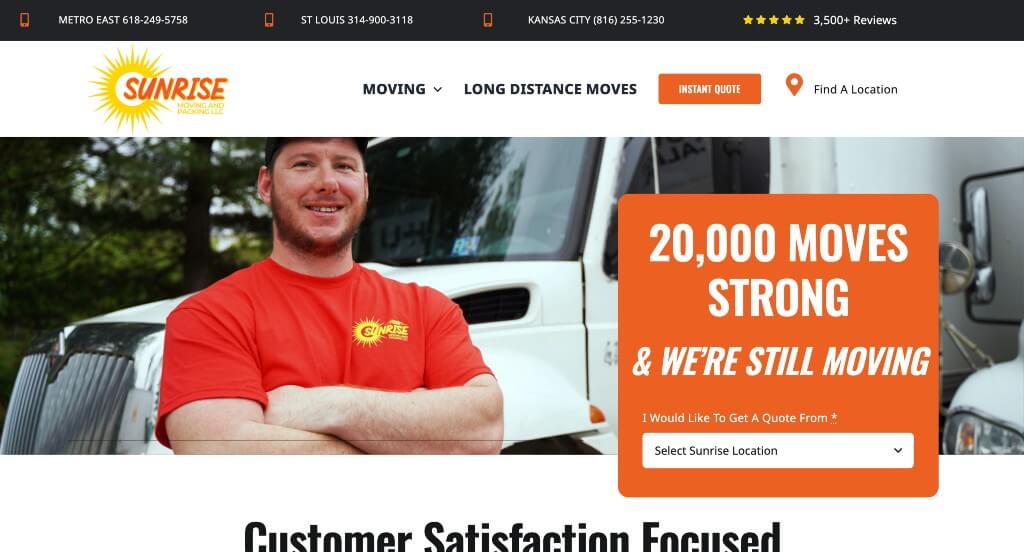
This company uses a logical color palette to breathe life into their pages, which is one of the first things we noticed. It was also nice to show off that they have moved lots of customers belongings out of their homes to prove that they are a reputable business. Content is written in very short form which is nice because viewers can skim through it faster. Lots of buttons were added in to keep pages looking less cluttered.
11. Meathead Movers
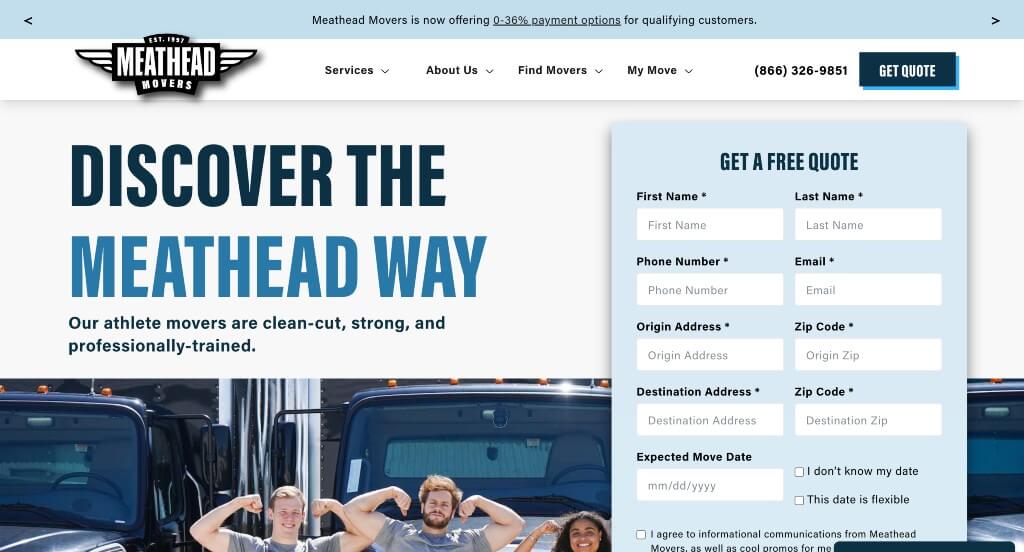
Showcasing a clean and intuitive layout, this site keeps things simple for a moving company website. Our web designers thought this website was a good design idea for moving companies because of their creative logo design. Their free quote survey was refreshing for a unique moving company site. They clearly had website accessibility in mind when building the display of awards their company has won. Don’t forget to check this website out while looking through our list of the best moving company sites!
12. Colonial Van Lines
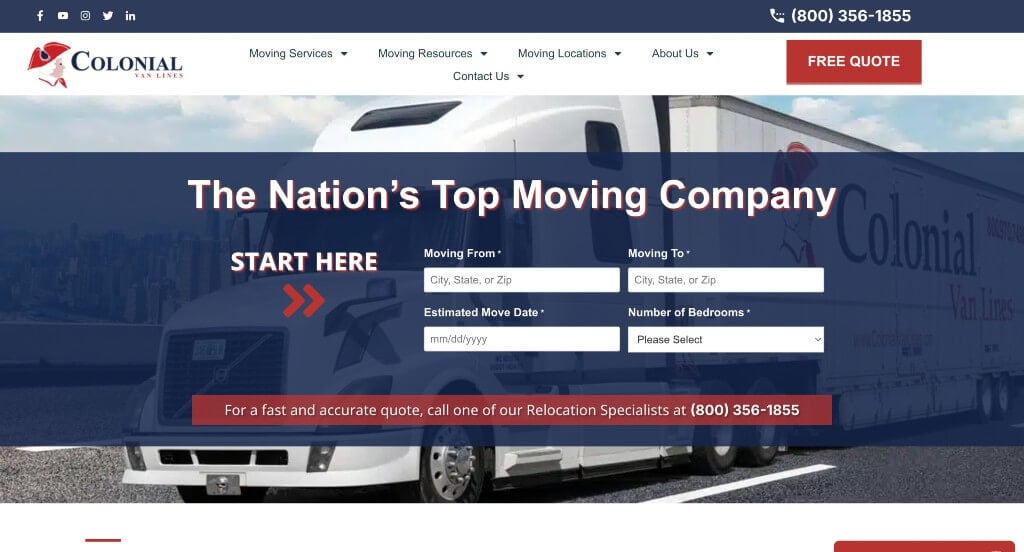
Colonial Van Lines has a great moving company website that uses white, blue and red for a color scheme. The use of a live chat section was probably the most impactful feature in the homepage of Colonial Van Lines. The calculator to estimate the cost of your move was definitely refreshing for a unique website. They had website marketing in mind when designing the interesting logo design for their company. Be sure to consider the great design of this moving company website when developing your next custom website.
13. Great Chicago Movers LLC
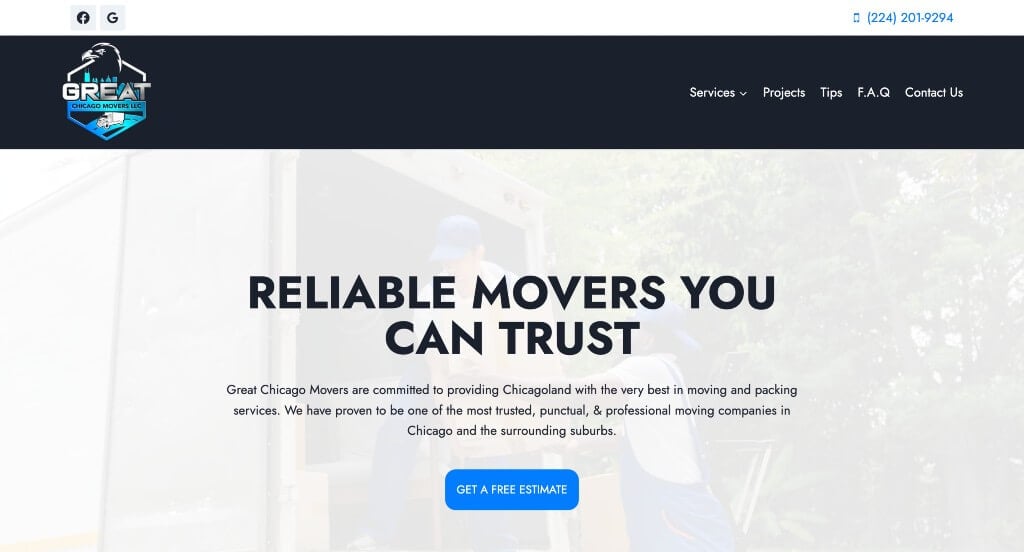
Great Chicago Movers LLC’s biggest plus was definitely their logo that included a moving truck, cityscapes, and an eagle. Blue accents can be noticed in many areas to highlight buttons and linking texts so viewers know where to click for more information. We really enjoyed the organization that is used for content within these pages. Adding in a moving gallery was another aspect that we found interesting.
14. TWO MEN AND A TRUCK
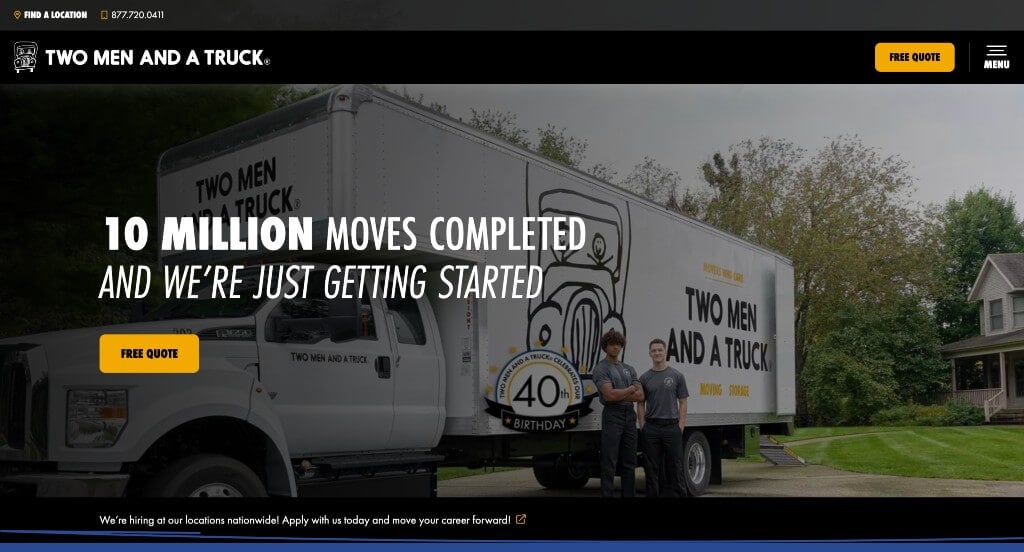
We immediately noticed the gray, black, white, blue and yellow color scheme used in the TWO MEN AND A TRUCK website, which we liked because it creates a sleek and professional design. After scrolling past the header of this moving company site, you’ll immediately notice their use of graphics. Another feature in this custom moving company site was their simple navigation. TWO MEN AND A TRUCK clearly had a focus on website usability when building the domain for their website that matches the company’s name. Any website designer building websites for moving companies will want to consider checking this website out.
15. Cross Country Moving Group
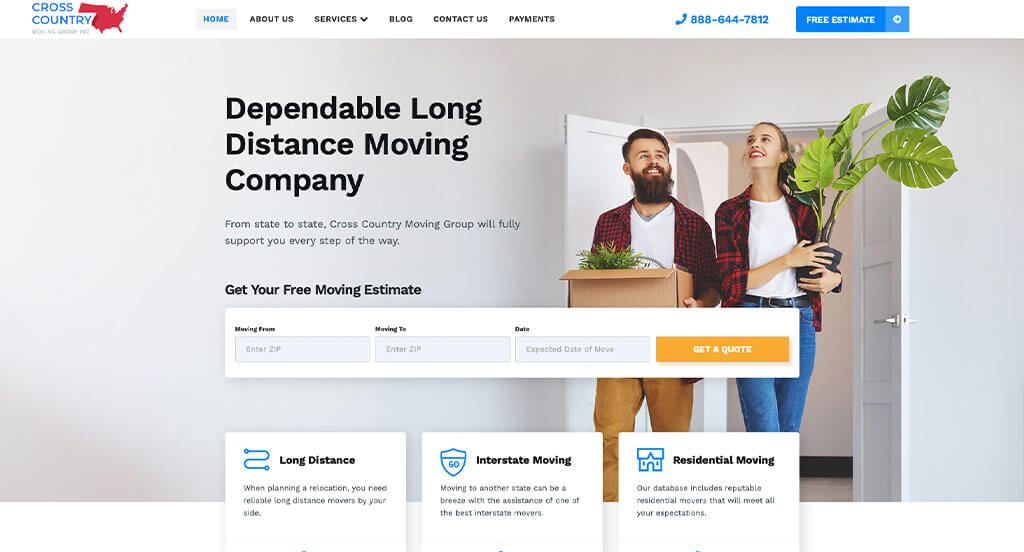
The website of Cross Country Moving Group ranked because it’s one of the better looking moving company websites we came across. The layout that was free of distractions was definitely the most impactful feature in the homepage of Cross Country Moving Group. Another thoughtful feature in this creative moving company site was the inclusion of customer reviews. They clearly had a focus on digital marketing when building the well organized content for their website. These were just a few of the numerous qualities in this website we had to consider when putting together this list of top websites for moving companies.
16. National Van Lines
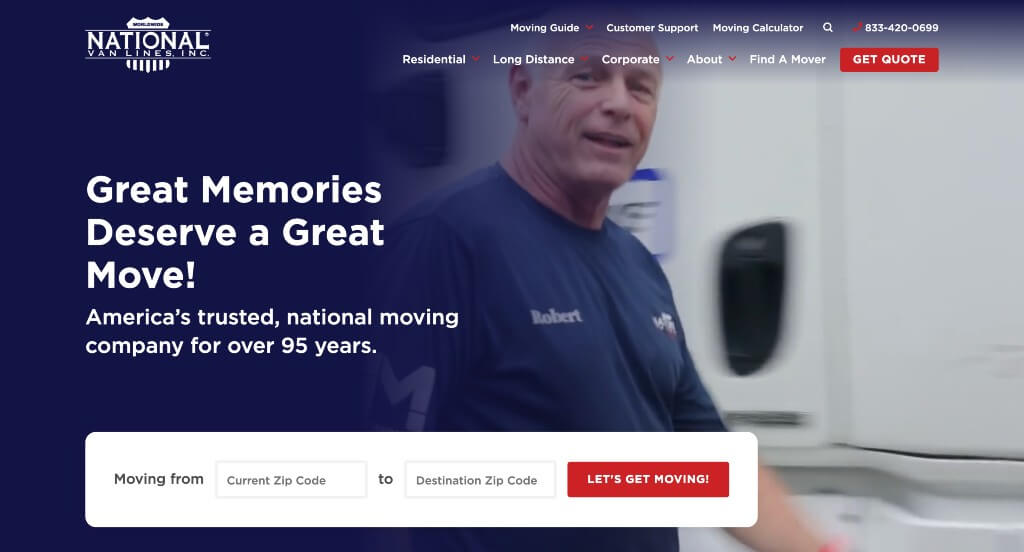
The National Van Lines website has a very classy feel to it, thanks to its blended use of red, white and blue. Of all the moving company websites we reviewed, one of the features in this custom website we liked was their interesting logo design. The larger fonts for their titles was a good choice for a unique website. From a marketing viewpoint, we liked the way this moving company website utilized buttons for simple navigation throughout their site. Give some thought to the great design of this moving company website when developing your next website.
17. Minne Movers
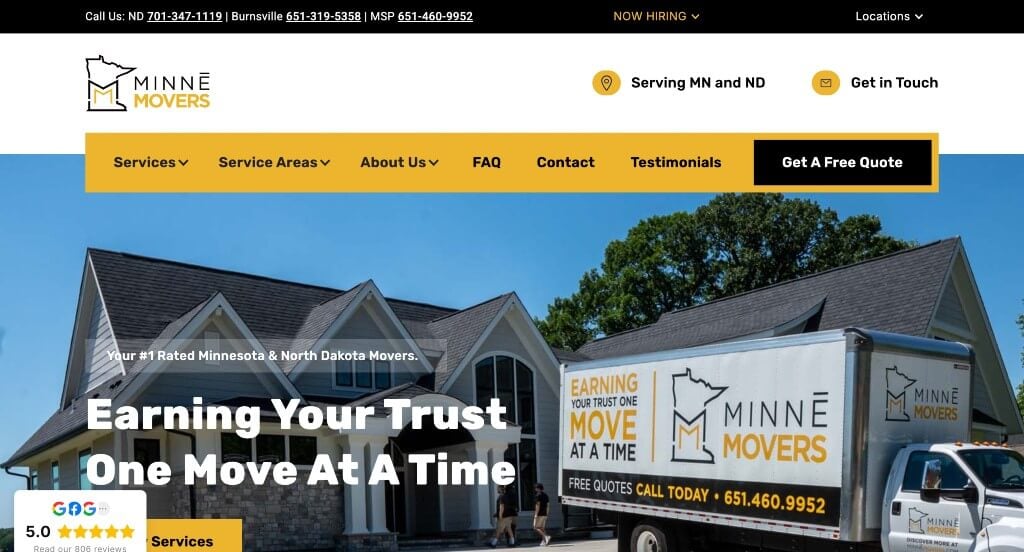
We chose Minne Movers because of its nicely organized moving company website that uses a white, yellow and black color scheme, which we like because it creates a creative design. The clever logo design was definitely the most impactful quality in the homepage of this website. The clearly labeled menu was another one of the reasons we included this website in our rankings for the top web design ideas for moving companies. They clearly had website marketing in mind when designing the optimized content for their website. With so many great reasons to consider this moving company website, it’s obvious why we included it in this list of the best websites!
18. Gentle Giant Moving Company
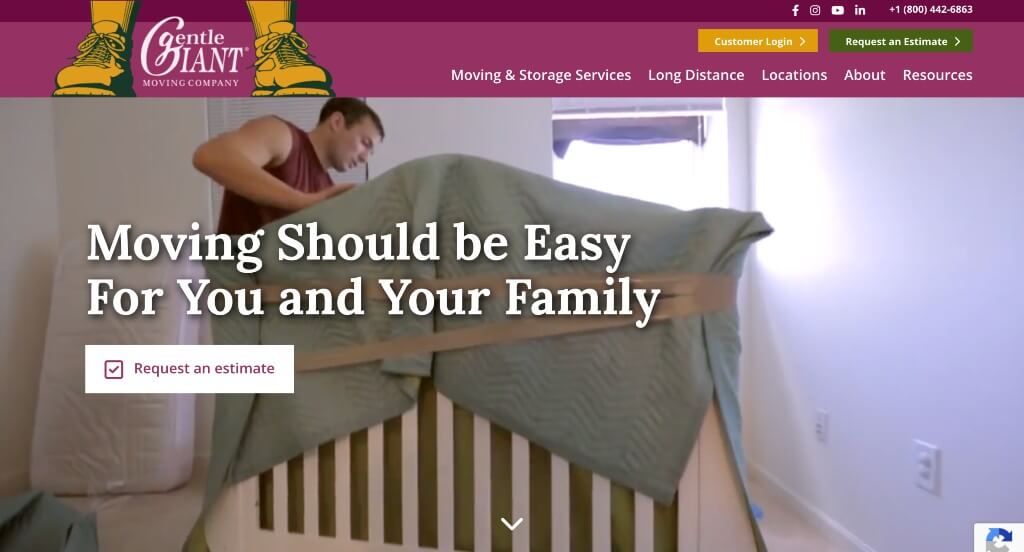
We chose Gentle Giant Moving Company because of its nicely organized website that uses a yellow, magenta, gray and white color scheme. Of all the custom moving company websites we reviewed, one of the features in this custom website we liked was their automatically playing video that catches the attention of viewers. The navigation bar with organized categories was another unique quality in this professional moving company site we enjoyed. Gentle Giant Moving Company clearly had a focus on conversations when including social media into their website. If you are looking for template examples for your next moving company site, give some thought to this one.
Related: Ready to launch some paid advertising campaigns for contractors on search engines or social media? We are here to help!
19. A1 Movers
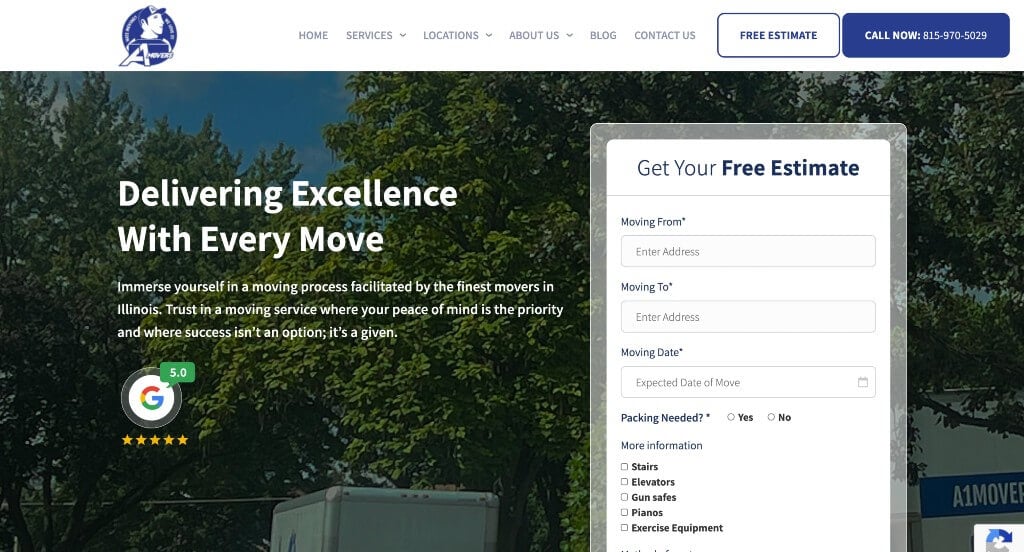
Here we have an example that makes great use of white space, and it’s carefully balanced. A1 Movers does an amazing job including information without ever being overwhelming. Adding in a frequently asked question area was another great addition. Listing areas that they serve was also helpful for anyone planning to hire them. Finally, we really liked how they occasionally used simple patterns in the backgrounds of their content.
20. Pure Moving
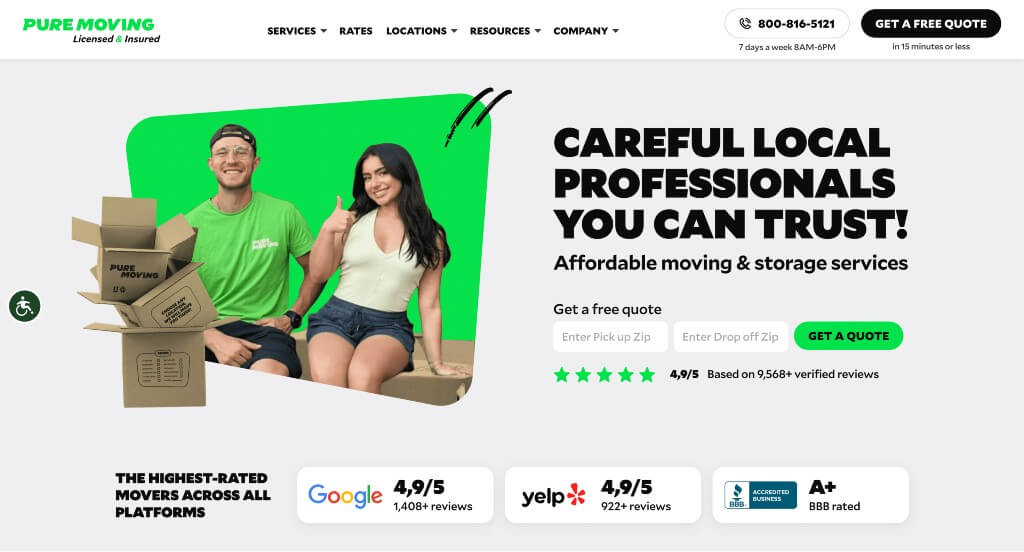
We appreciated how this moving company website used the colors of green, white and blue to create a custom web design layout. After scrolling past the header of this moving company website, you’ll immediately notice their use of a variety of graphics. This clean moving company site also does a good job with their organized flow of information. They clearly had a focus on website accessibility when creating the well-labeled navigation bar for their website. Be sure to consider the creative design of this moving company website when building out your next website.
21. Pack-Men Movers
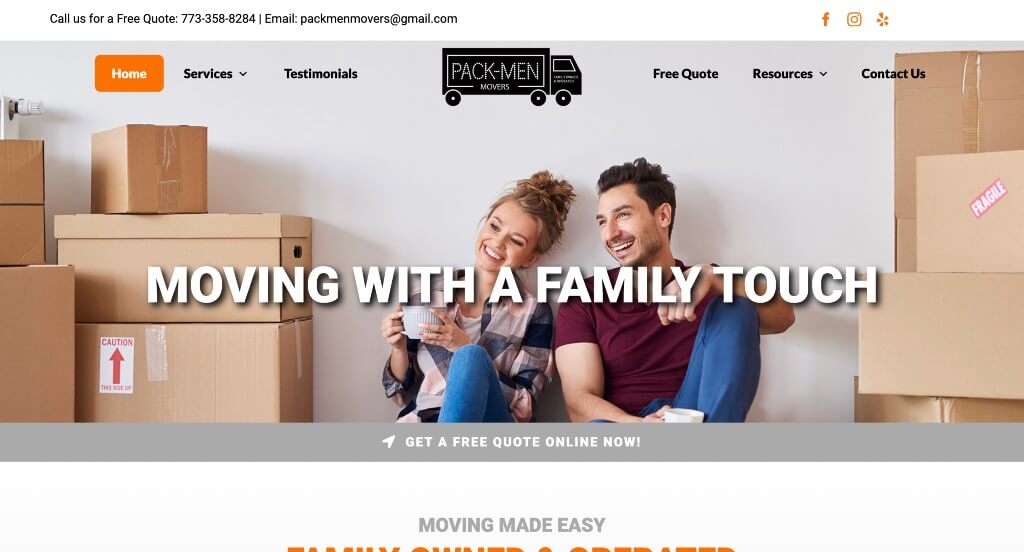
This was a very simplistic design where orange highlights content within their pages. Lots of images were included to show pride in their business, which was an amazing choice. Offering a free quote for anyone wishing to see if this business is for them is a choice that everyone can appreciate. It was a also a great choice to use their company name as their domain.
22. Relief Moving Company
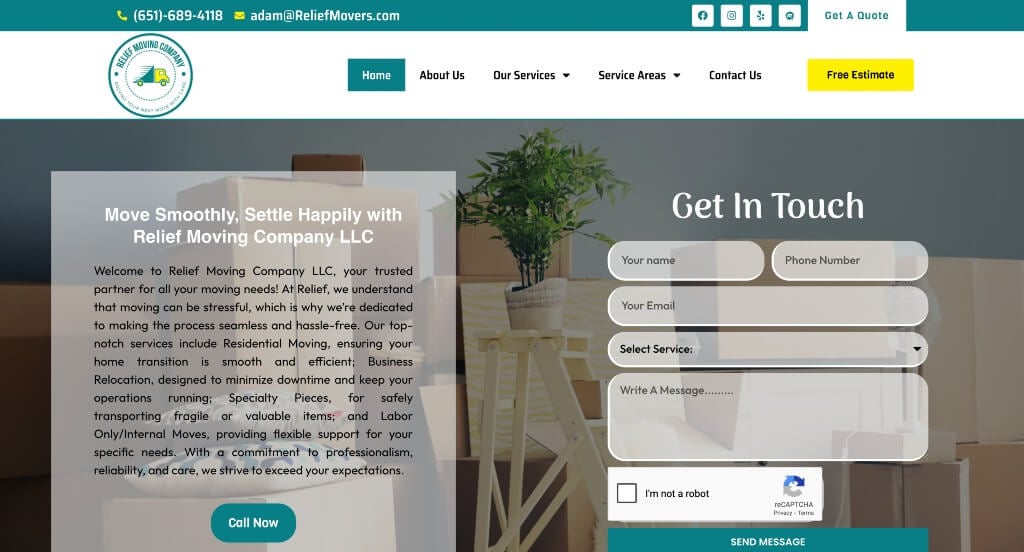
This is a great website design example for moving companies who are looking for a custom website. After scrolling past the navigation of this moving company site, you’ll notice their stunning color palette. The inclusion of a blog was a good choice for a professional moving company site. From a marketing point of view, we liked the way this moving company website utilized simple navigation. Don’t scroll past this website when considering design ideas for your next moving company website!
23. Accurate Express Movers
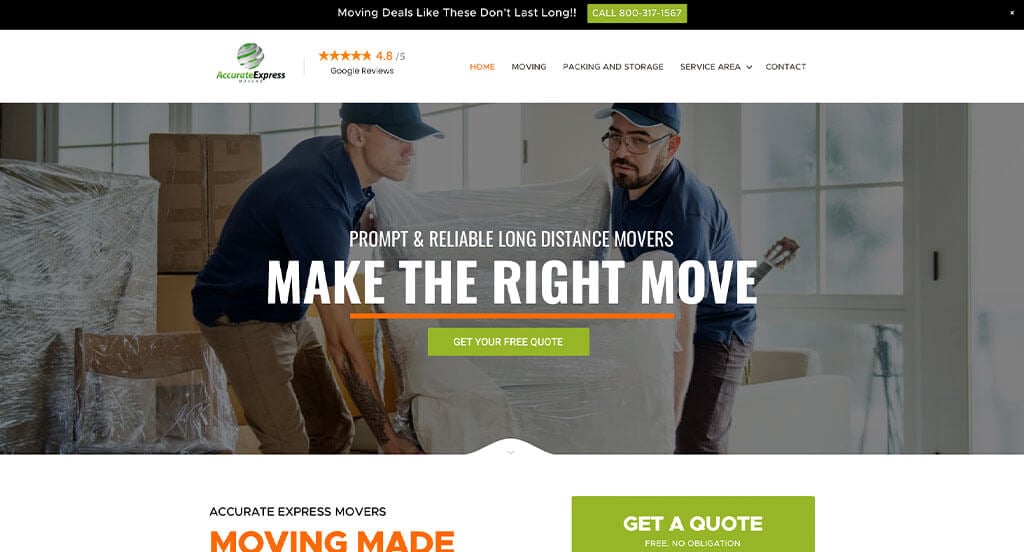
This is a good example of a website design for moving companies who are looking for a custom site layout. After scrolling past the header of this moving company website, you’ll immediately notice the large fonts. This clean moving company site also does a good job with their customer review section. They clearly had a focus on website usability when building the clearly labeled menu for their website. What a great website to review when designing your next website!
24. Interstate Moving & Relocation Group
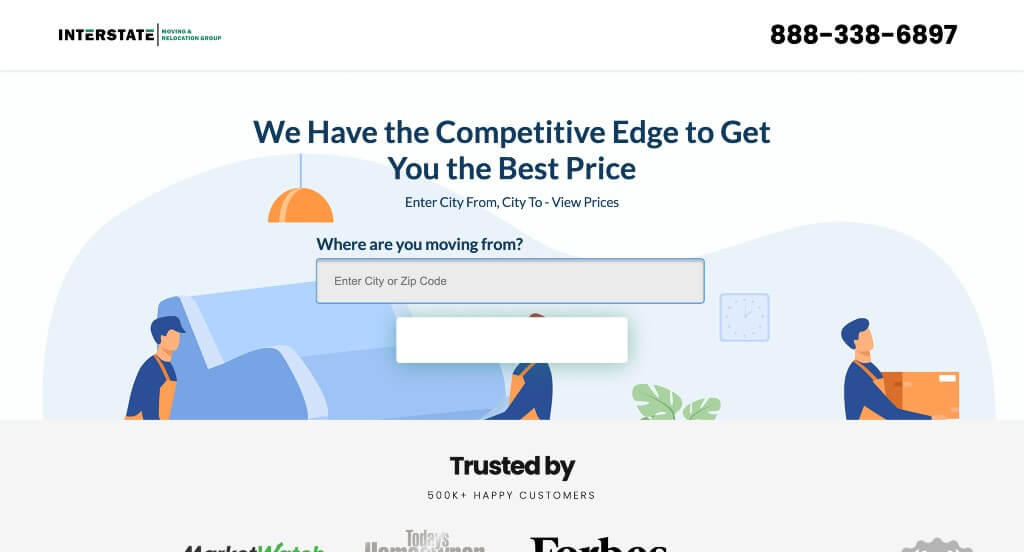
This is a creative website design example for a moving company looking to build their next professional website. After scrolling past the navigation of this moving company website, you’ll notice their logically organized information. The layout with a good balance of white space was a nice touch for a unique site. They had ease of use in mind when designing the simple contact information for their website. Don’t skip past this website when hunting for design ideas for your next moving company website!
25. American Van Lines
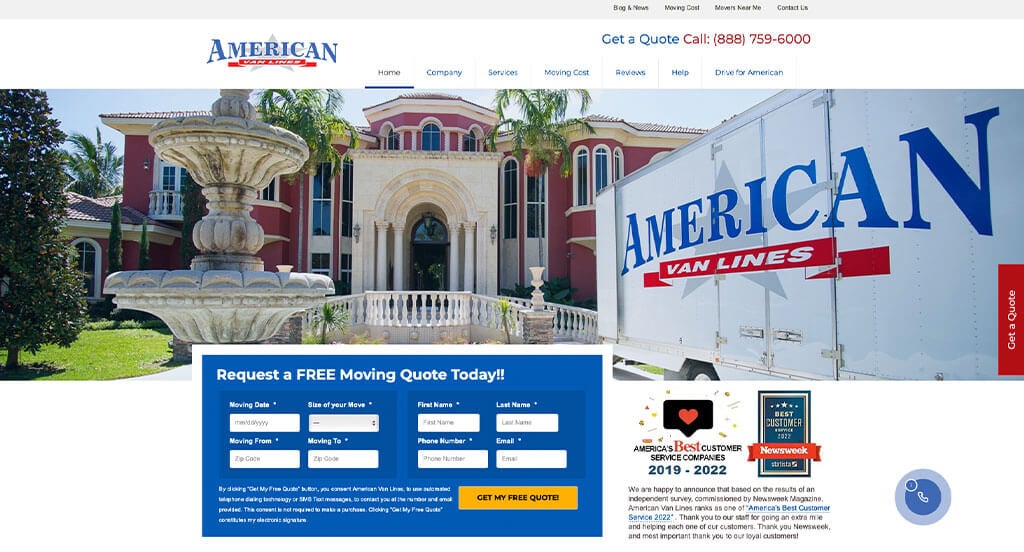
The website of American Van Lines ranked because it is one of the nicer moving company websites we reviewed. As you scroll through the homepage of this website, one of the design qualities we liked was their thoughtful color scheme. Another thoughtful quality in this clean moving company website we noticed was the addition of testimonials. They clearly had website marketing in mind when including a blog into their website. Give some thought to the one-of-a-kind design of this moving company website when developing your next custom website.
26. 1-800-PACK-RAT
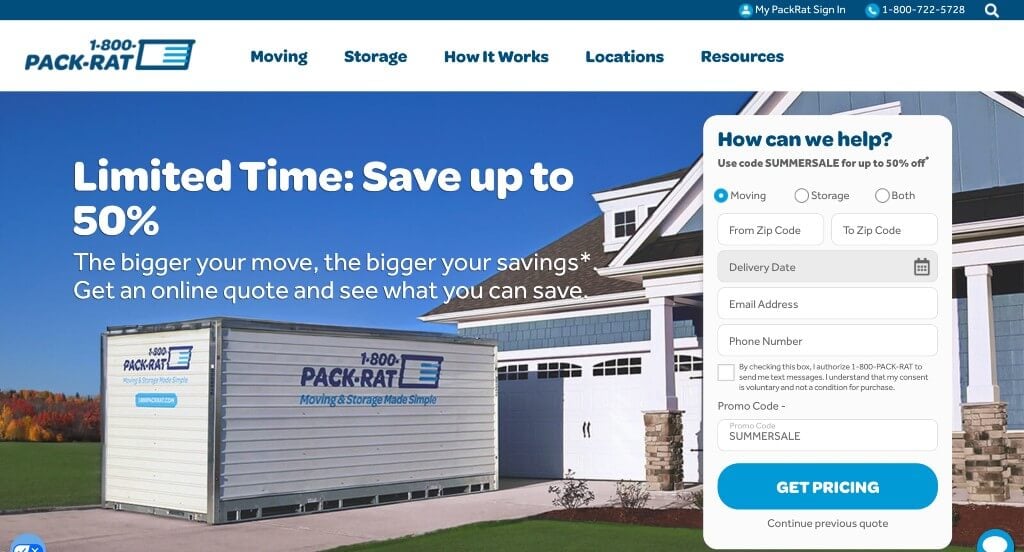
This is a great website design example for a moving company looking to pull inspiration for a custom website. The use of a creative font was definitely the most impactful quality in the homepage of 1-800-PACK-RAT. Another thoughtful feature in this professional moving company site we liked was the use of different graphics. The soothing color palette helped make this one of the best moving company websites we looked at. These were just a few of the numerous qualities in this website we had to consider when putting together the list of top websites for moving companies.
27. Great Home Movers
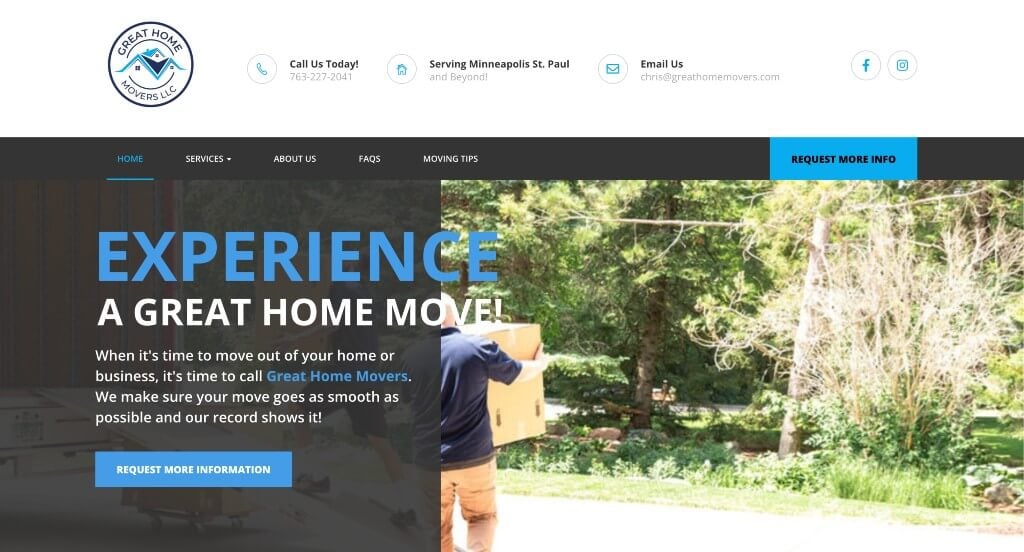
This is a good example of a web design for moving companies who are looking for a custom website. Our web designers thought this website was a good example for moving companies because of their smooth transitions. This clean moving company site also does a good job with their subtle animations. Great Home Movers clearly had a focus on website marketing when creating the stunning layout for their website. Talk about a great website to have included in this list!
28. Cheap Movers Los Angeles
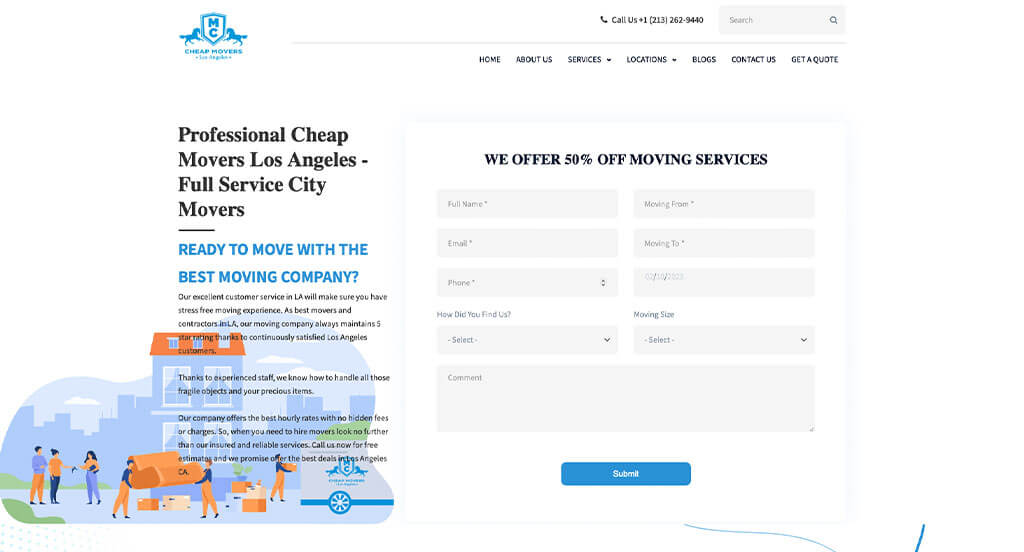
This is a great web design example for moving companies who are looking for a professional layout. After scrolling past the navigation of this moving company site, you’ll notice their inclusion of graphics for their backdrop. The short and to the point paragraphs were a good choice for a custom site. They had website accessibility in mind when building the domain for their website that matches their company’s name. Don’t scroll past this website when considering design ideas for your next moving company website!
29. New City Moving
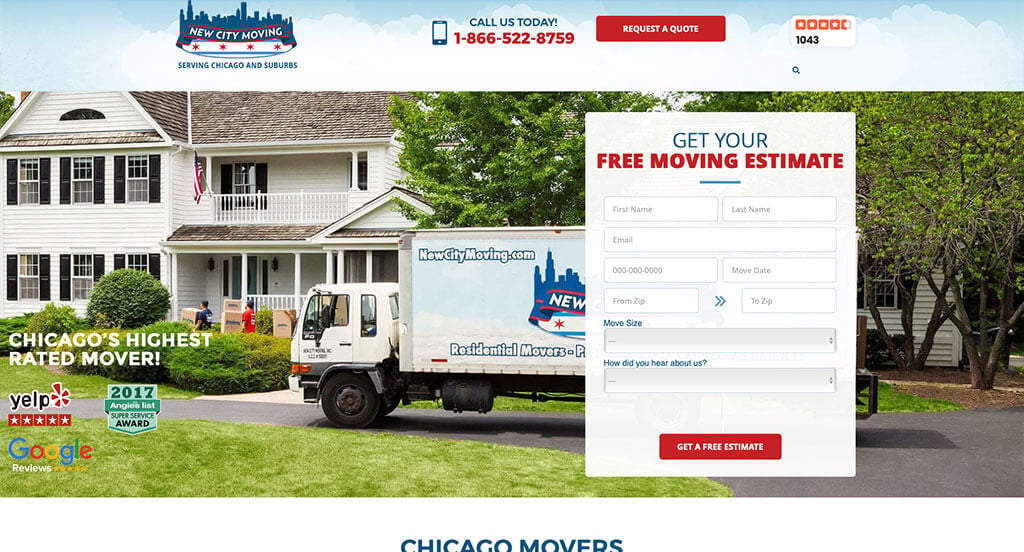
This is a good example of a website design for moving companies who are looking for a professional layout. While most moving company websites share this quality, we thought New City Movers did a nice job with their color palette. The interesting logo design was another reason why we included this website in our list of the best websites for moving companies. From a marketing viewpoint, we liked the way this moving company website utilized brightly colored buttons to help navigate throughout their site. For the moving companies out there checking website examples, make sure to check this one out!
30. Bellhop
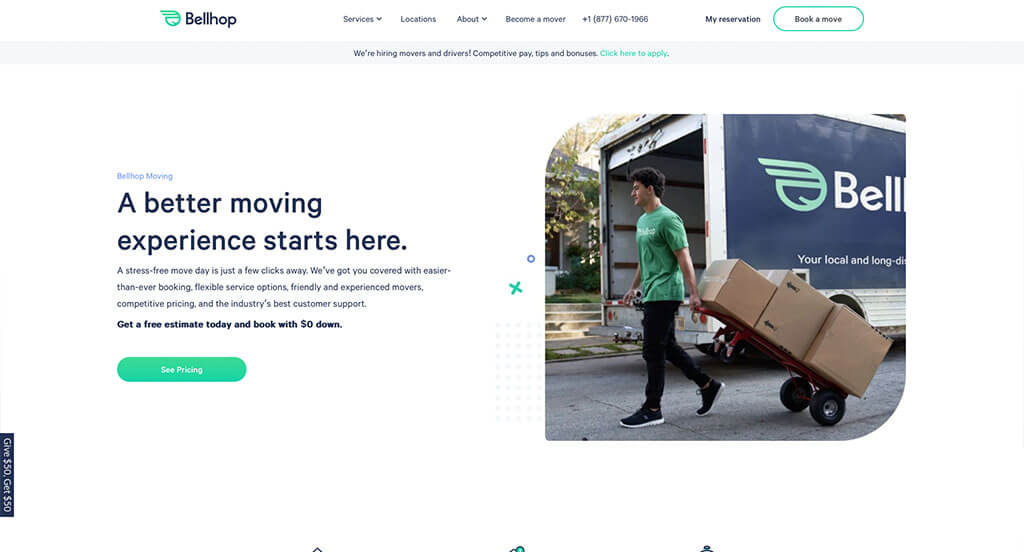
The white, black and aqua colors used in this moving company site stood out to us because it was unique. Our web designers thought this was a good homepage design example for moving companies because of their interesting photo frames. The layout with a good balance of white space was refreshing for a unique website. They had ease of use in mind when creating the well labeled navigation bar for their website. What a great website to review when building out your next website!
31. Solomon & Sons Relocation Services
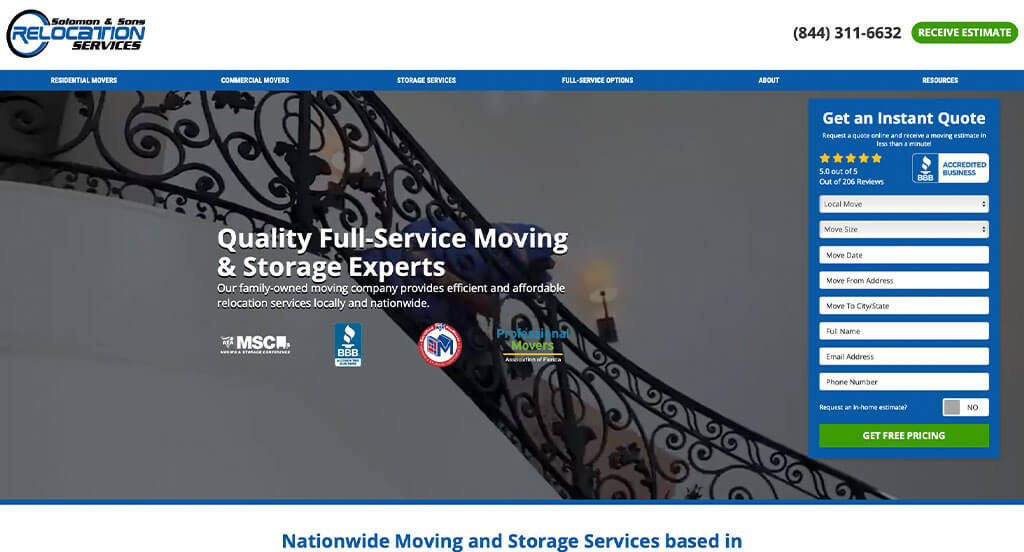
We liked how this moving company site combined the colors of black, white and blue to create an attractive website layout. We thought this was a good example of a homepage layout for moving companies because of their instant quote section. Another design quality in this professional moving company website we liked was the buttons to enhance usability. They had website accessibility in mind when creating the simple contact information for their website. Be sure to consider the one-of-a-kind design of this moving company website when developing your next custom website.
Related: Contractor SEO is an effective way to bring in quality traffic to your website! Don’t lose out on easy traffic wins by neglecting your website.
32. Bekins
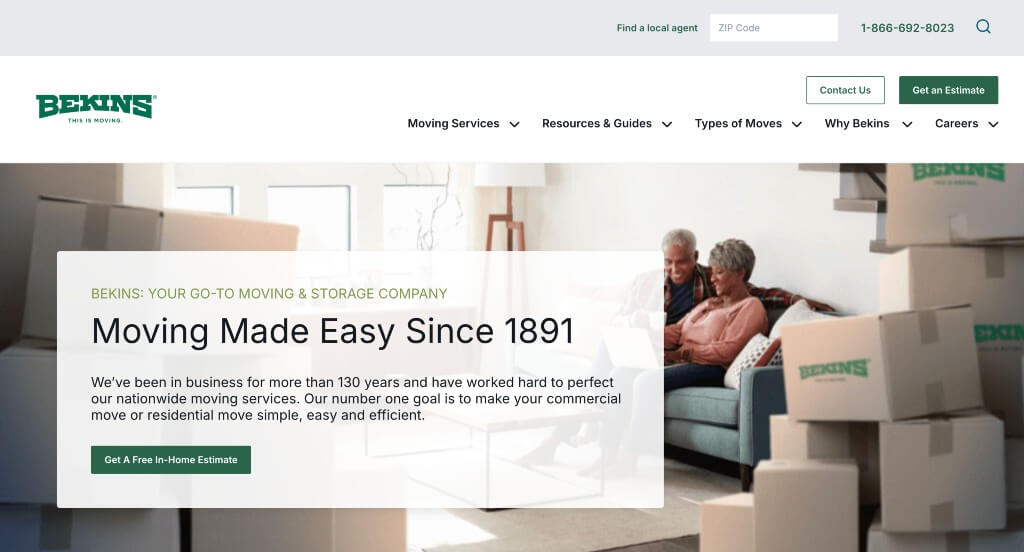
If you are looking for inspiration, Bekins was a great example to look at. Having a navigation bar with drop downs in order to keep everything extremely organized was smart. We enjoyed this green and white color palette because it was different, but also very relaxing. Being able to place a zip code search bar so customers can find a local agent was a nice feature.
33. JK Moving Services
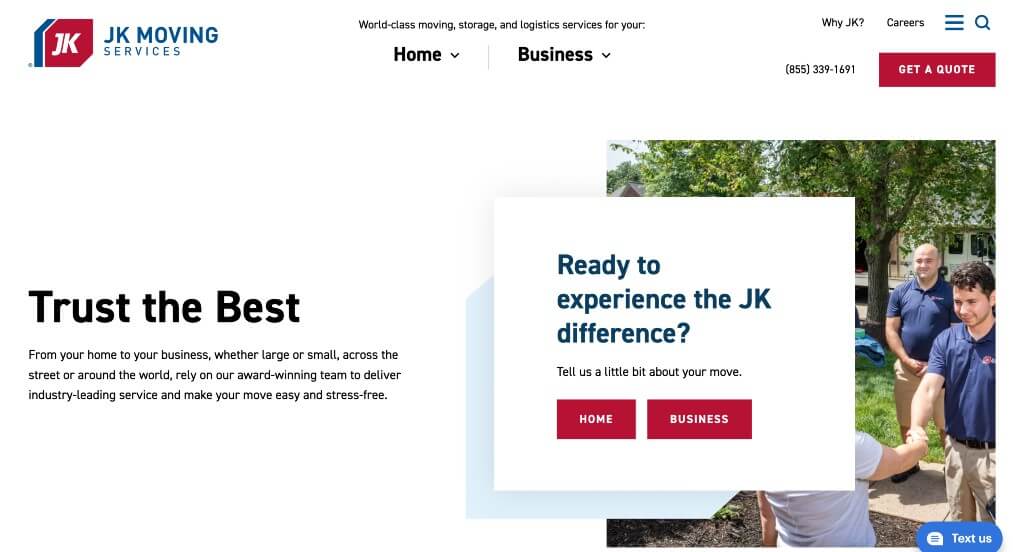
This is a good example of a moving company website design for someone who is looking for a professional layout. The unique shapes used to pattern their background was definitely the most impactful quality in the homepage of this website. The use of a search bar was definitely refreshing for a custom moving company site. JK Moving Services had ease of use in mind when creating the clearly labeled menu for their website. If you are looking for template examples for your next moving company site, give some thought to this one.
34. North American Van Lines
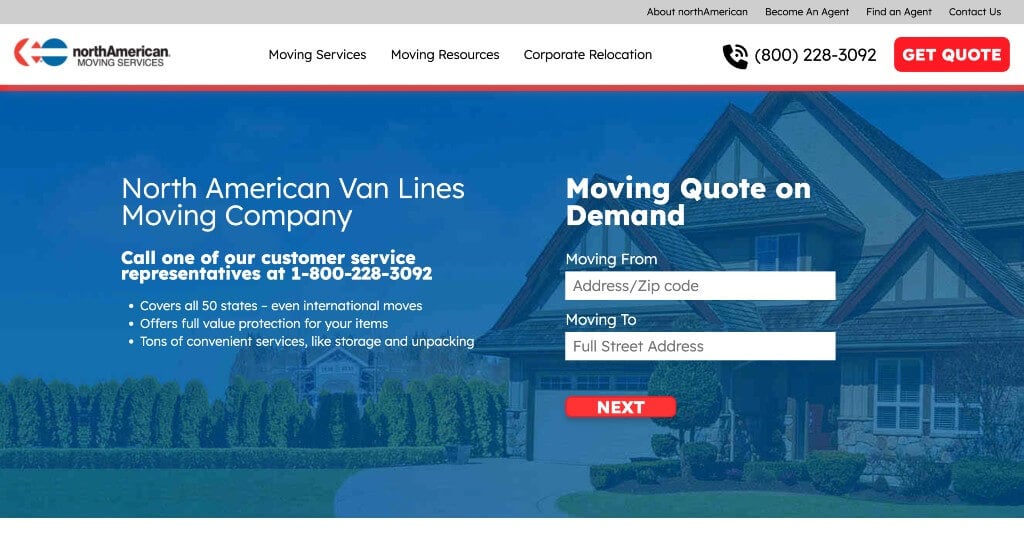
This is a great moving company web design example for someone who is looking to develop a professional website. After scrolling past the header of this moving company site, you’ll immediately notice their layout with a good balance of imagery, graphics and text. Their use of different sized fonts was definitely refreshing for a professional site. They clearly had website marketing in mind when creating the customer review section for their website. You won’t be disappointed after reviewing this website for design ideas for your next website!
35. Allied
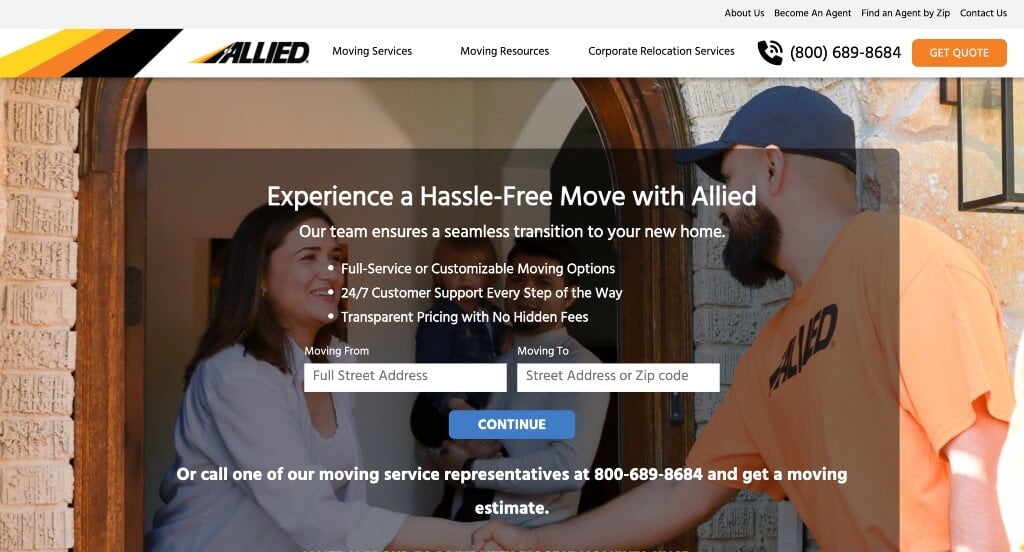
This is a good example of a website design for moving companies who are looking for a custom look and feel for their next site. The stunning template was likely the most impactful feature in the homepage of this website. Their display of their awards was refreshing for a professional site. They clearly had a focus on conversations when designing the unique logo design for their company. Give some thought to the one-of-a-kind design of this moving company website when developing your next website.
36. College H.U.N.K.S. Hauling Junk & Moving
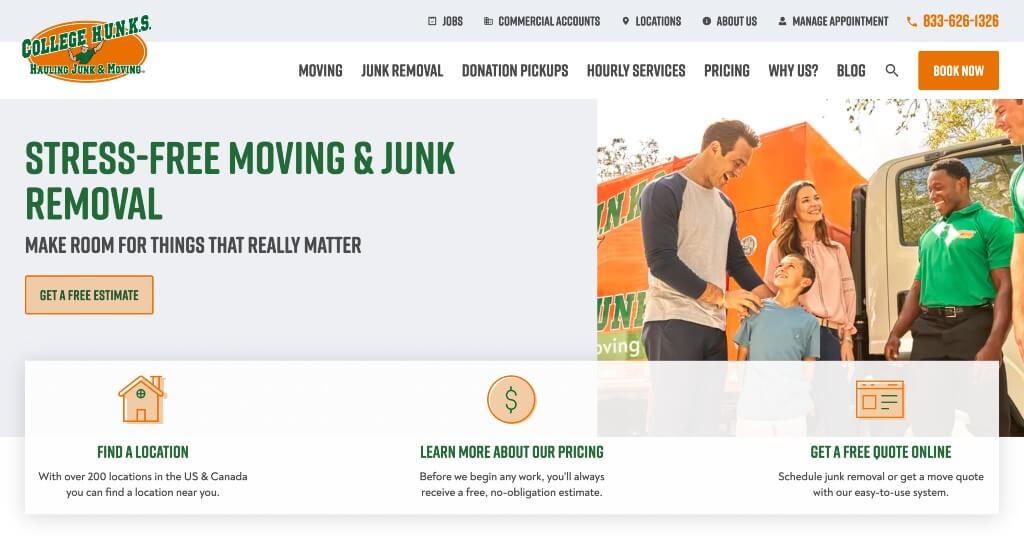
This is a creative website design example for a moving company to check out when looking to build their next website. After scrolling past the header of this moving company site, you’ll immediately notice their use of small graphics and icons throughout the site. The different fonts were a nice choice for a professional moving company website. College H.U.N.K.S. Hauling Junk & Moving clearly had marketing in mind when designing the blog for their website. These were just a few of the numerous qualities in this website we had to consider while putting together this list of top websites for moving companies.
37. College Muscle Movers
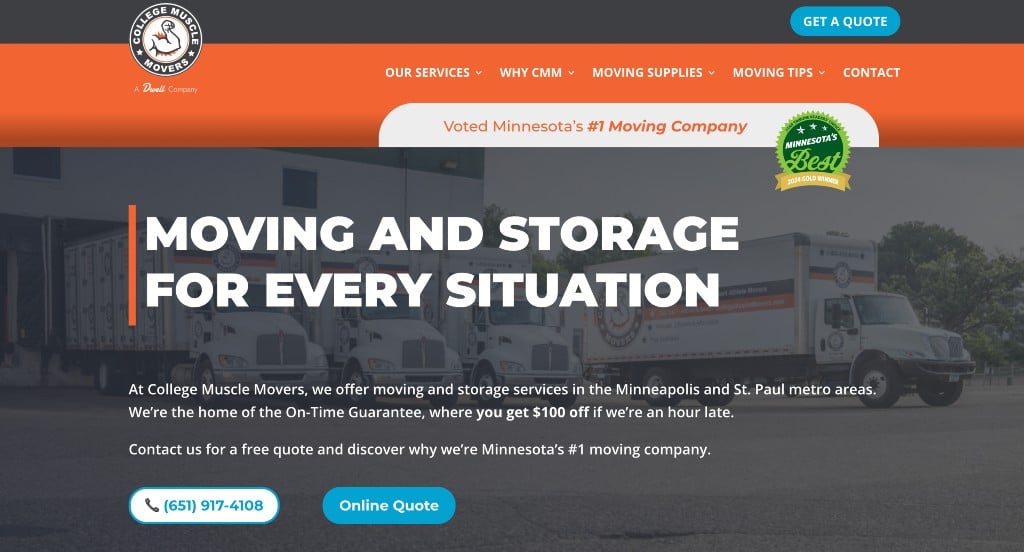
This is a great moving company web design example for anyone who is looking for a professional look and feel. After scrolling past the header of this moving company website, you’ll notice their logically organized information. The addition of a FAQ section in this website helped it make it into our list of the best websites for moving companies. They clearly had a focus on website accessibility when building the navigation bar with organized categories for their website. For moving companies who are looking for examples for their next website layout, this example will for sure be one to keep in your back pocket.
38. Arizona Discount Movers
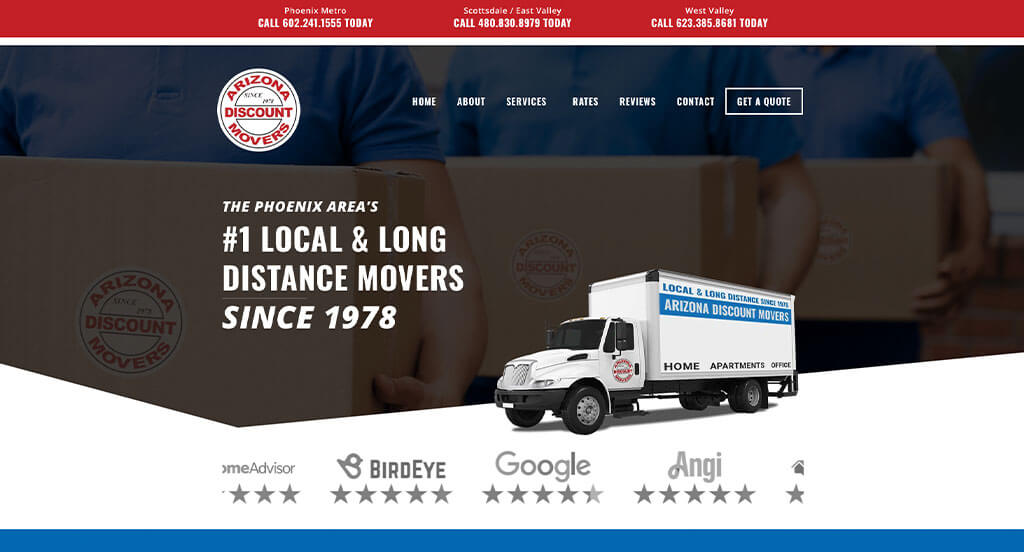
We appreciated how this moving company website used the colors of red, white and blue to create a custom web design. As you scroll through the homepage, one of the design qualities we liked was the different sized fonts to emphasize a statement. The page dedicated to their rates was another unique quality in this custom Moving Company site we enjoyed. They clearly had a focus on website usability when designing the clearly labeled menu for their website. Don’t scroll past this website when considering design ideas for your next moving company website!
39. 2 Fellas Moving Company
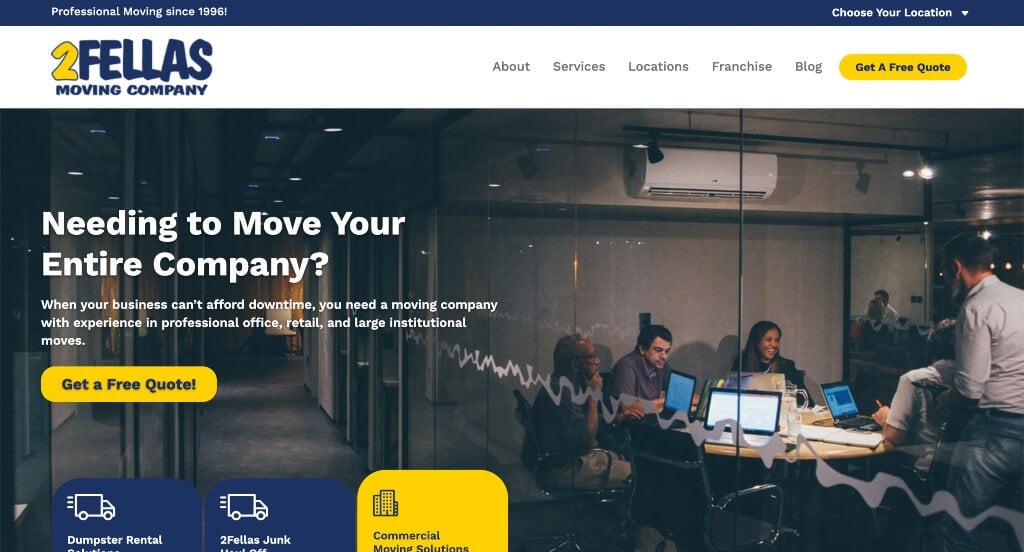
We quickly noticed the yellow, white and blue color scheme used in the Arizona Discount Movers website. The use of buttons to enhance usability was probably the most impactful quality in the homepage of 2 Fellas Moving Company. simple layout was absolutely a consideration when ranking 2 Fellas Moving Company in this list of the best moving company websites. 2 Fellas Moving Company clearly had digital marketing in mind when designing the inclusion of bullet points for their website. With so many great reasons to consider this moving company website, it’s no wonder we included it in this list of the best websites!
40. Unpakt
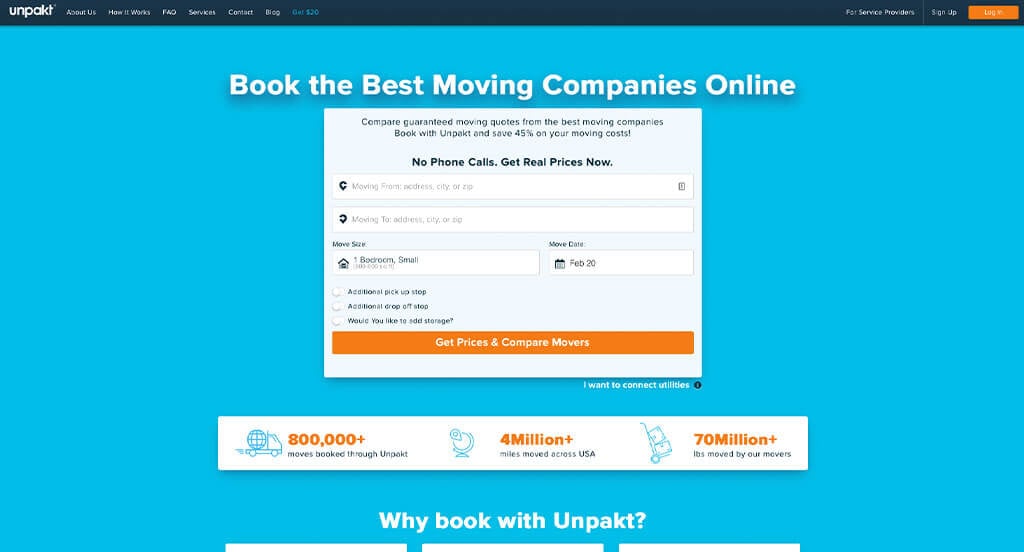
This is a great example for moving companies who are looking for a professional look and feel for their next website. The most attention grabbing aspect in this moving company website was definitely their use of graphics. Another thoughtful feature in this professional moving company site was the use of a FAQ page. Unpakt clearly had conversions in mind when designing the domain for their website that matches their company’s name. Be sure to consider the creative design of this moving company website when developing your next website.
41. Dreiske Moving & Storage
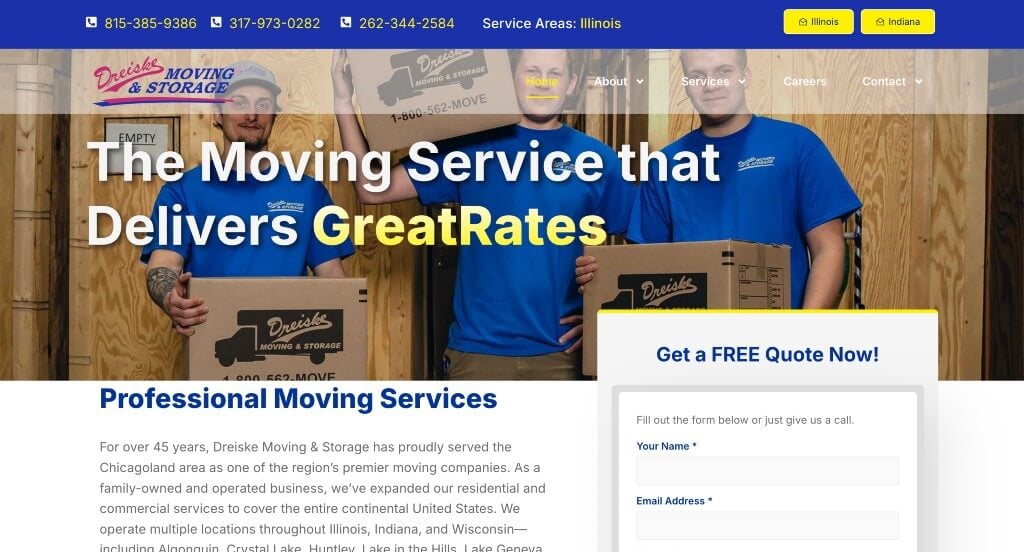
There was lots of images that were used throughout these pages, which made for pleasing templates for sure. Short paragraphs are carefully utilized in order to keep information easy to read and stay engaged with. Bullet points are also used to organize information into lists, making it easy for those who are reading through it. Adding in statistics related to years in business, customers helped, and mass moved was a great idea.
42. Atlas Van Lines
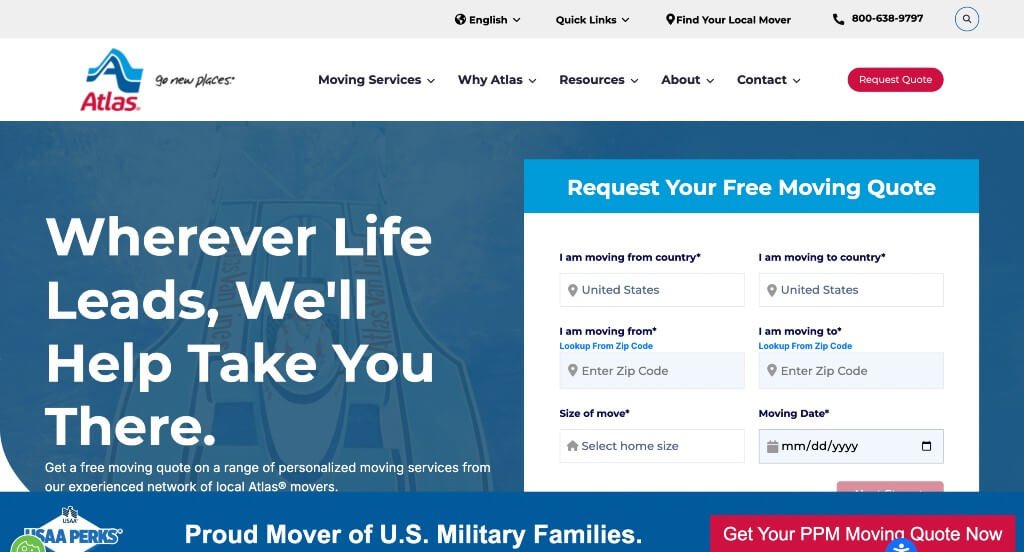
This is a great website design idea for a moving company who is looking for a custom look and feel for their next web design template. After scrolling past the header of this moving company website, you’ll notice their use of imagery to navigate throughout the site. The large text to emphasize statements was a nice touch for a unique website. From a marketing perspective, we really liked the way they utilized a customer review section. If you are looking for template options for your next moving company site, be sure to check this one out.
43. Einstein Moving Company
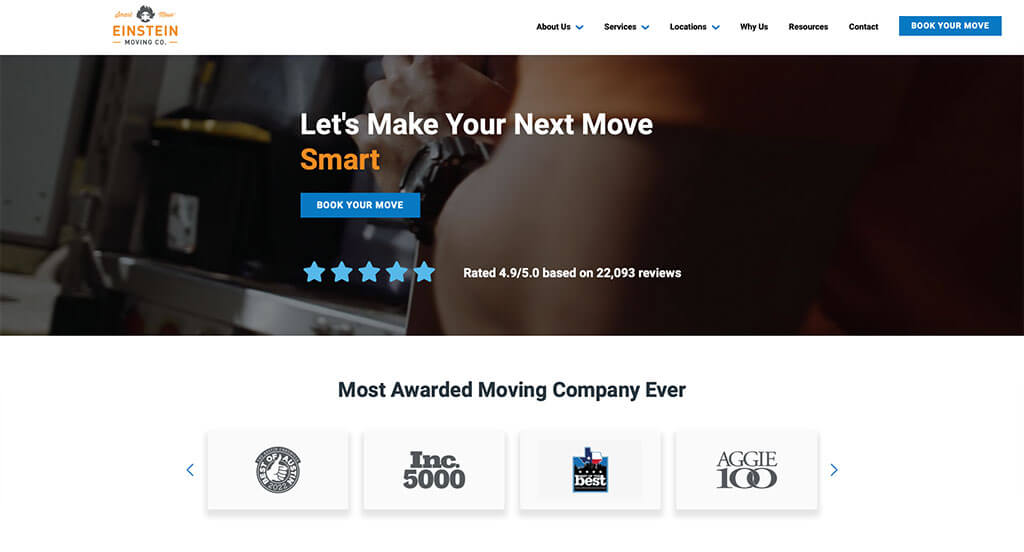
This is a great website design idea for a moving company looking for a custom look and feel for their next web design template. The most refreshing part of this moving company website was the automatically playing video that captures viewers attention. Another feature in this professional moving company website was their creative logo that matches their company name. Einstein Moving Company had internet marketing in mind when designing the clearly labeled menu for for their website. These were just a few of the numerous qualities in this website we had to consider when putting together this list of top websites for moving companies.
44. U-Pack
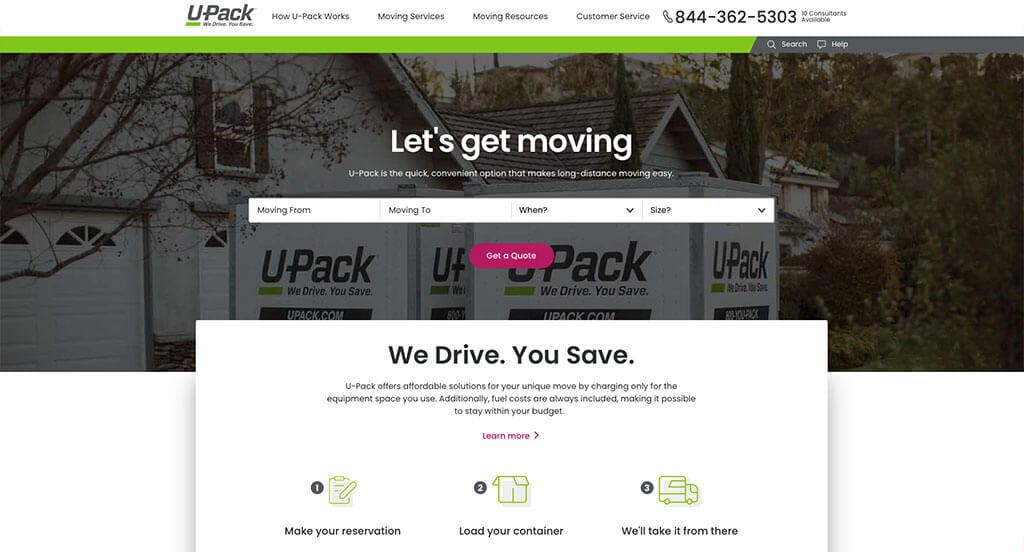
This is a good example of a web design for moving companies who are looking for a custom layout. Our web designers thought this was a good homepage design example for moving companies because of their simple layout. The creative photo frames were a nice touch for a custom website. They clearly had conversions in mind when designing the simple contact information for their website. Don’t forget to check this website out while looking through our list of the best moving company websites!
45. Pods
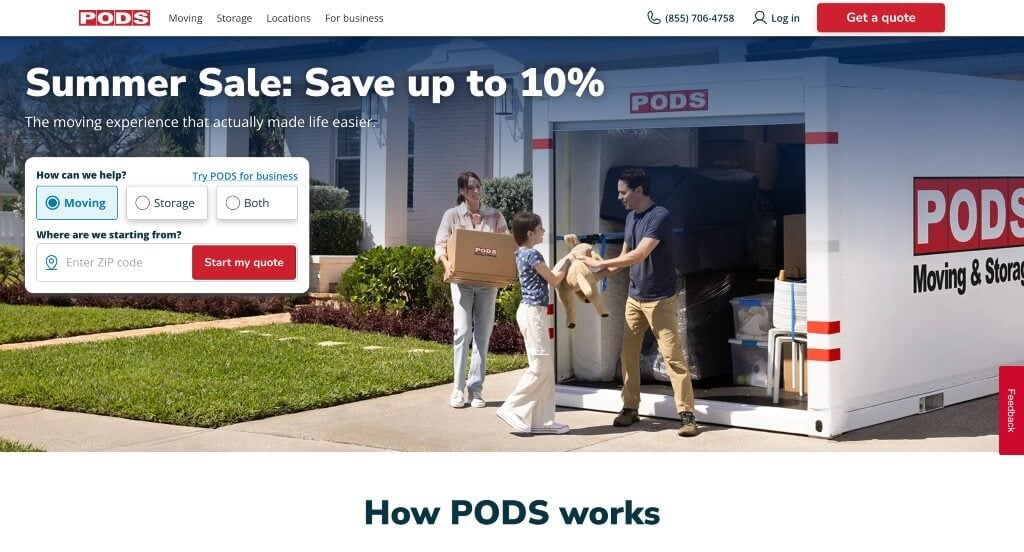
This is a great example for moving companies who are looking for a professional website design. While most moving company websites share this quality, we thought Pods did a nice job of with the display of their awards. The buttons for simple navigation was another reason why we included this website in our rankings for the top website layout ideas for moving companies. From a marketing perspective, we really liked the way they utilized bullet points to organize their information. For moving companies who are looking for ideas on their next website, this example will definitely be one to keep in mind.
WordPress Moving Company Themes
You can find free themes at wordpress.org, or explore moving company templates on ThemeForest.
Mover – Themeforest
$49
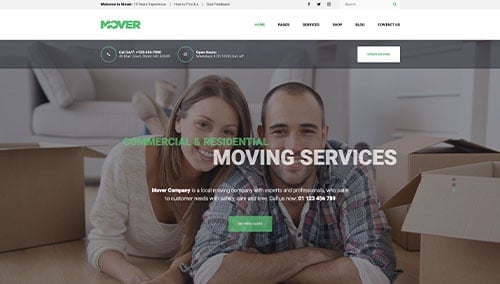
MoveMe – Themeforest
$69

MoversCO – Themeforest
$69
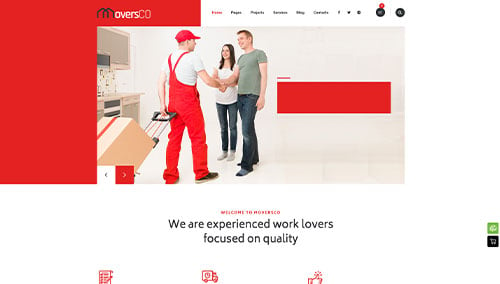
MoveIt – Themeforest
$29
